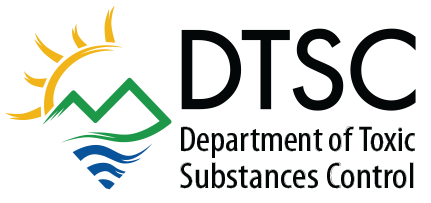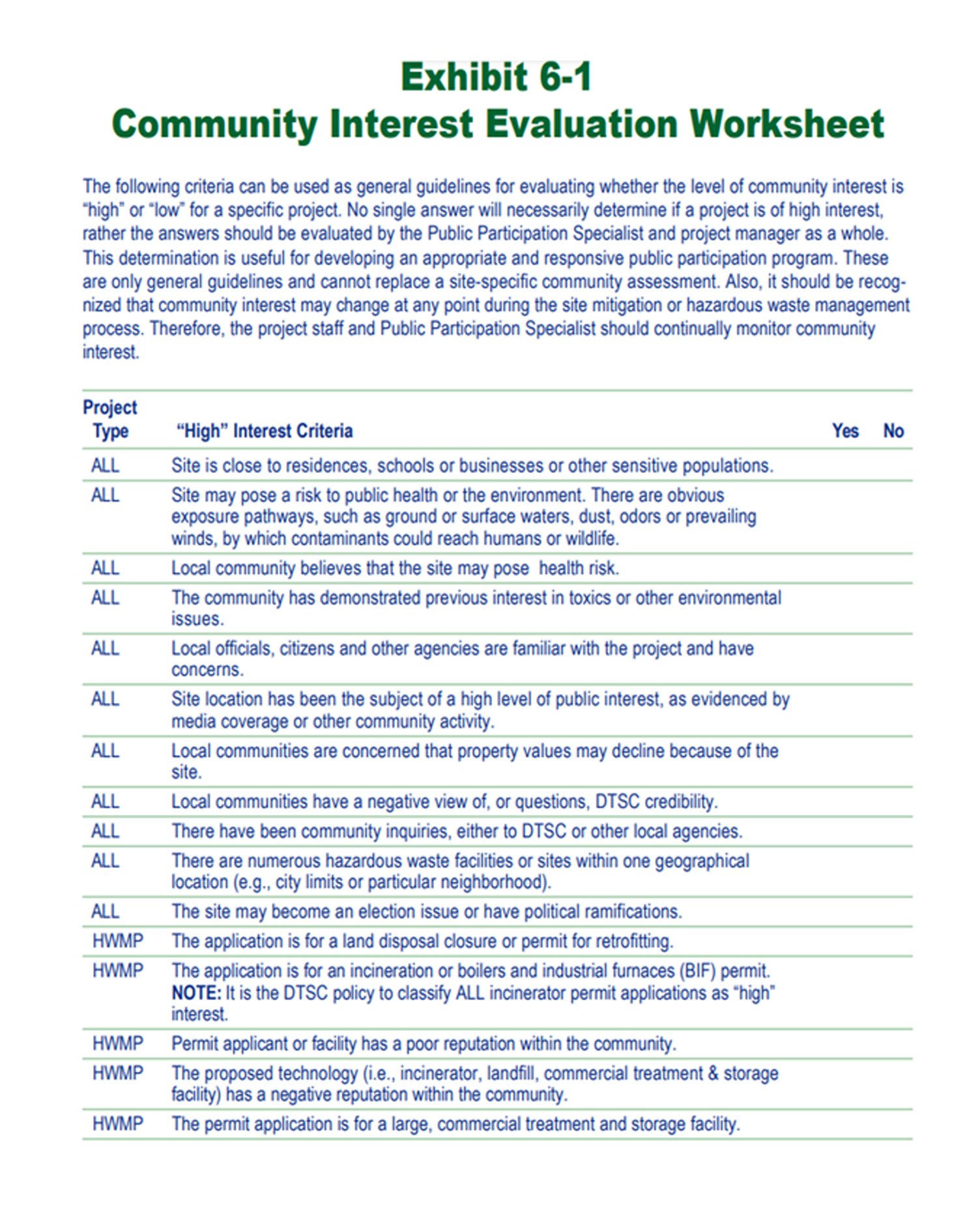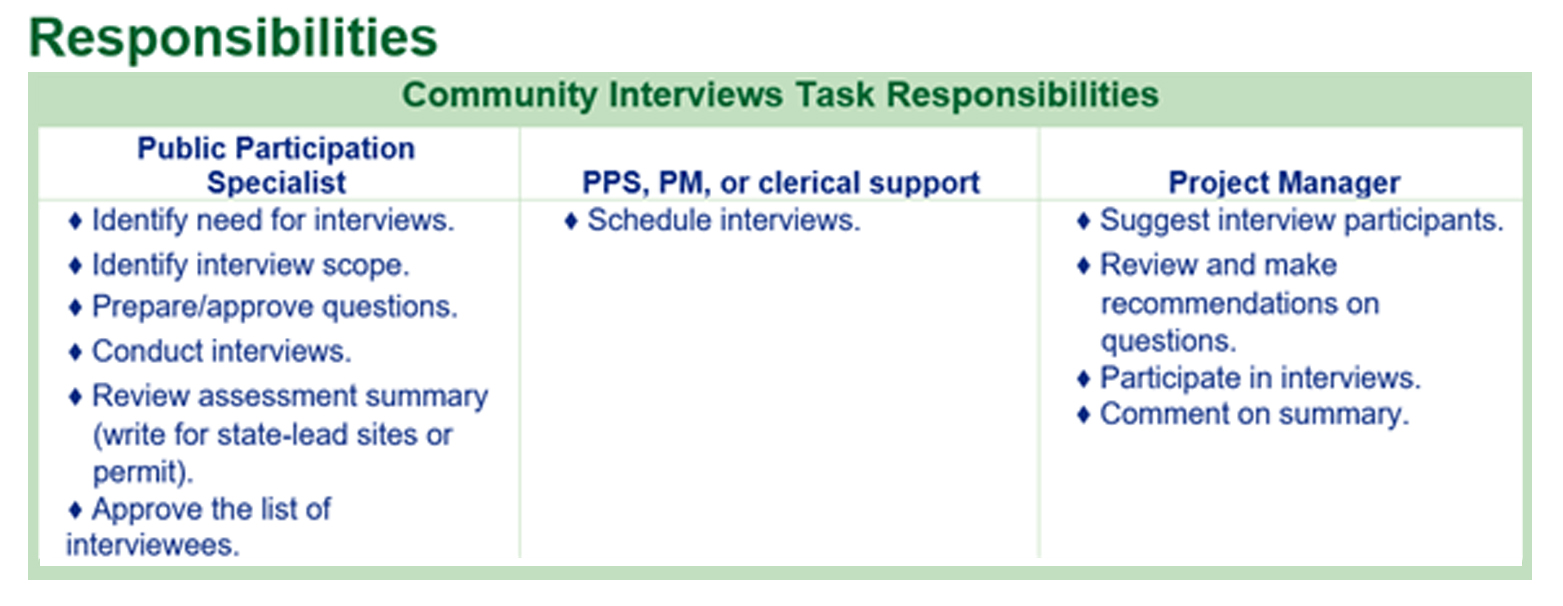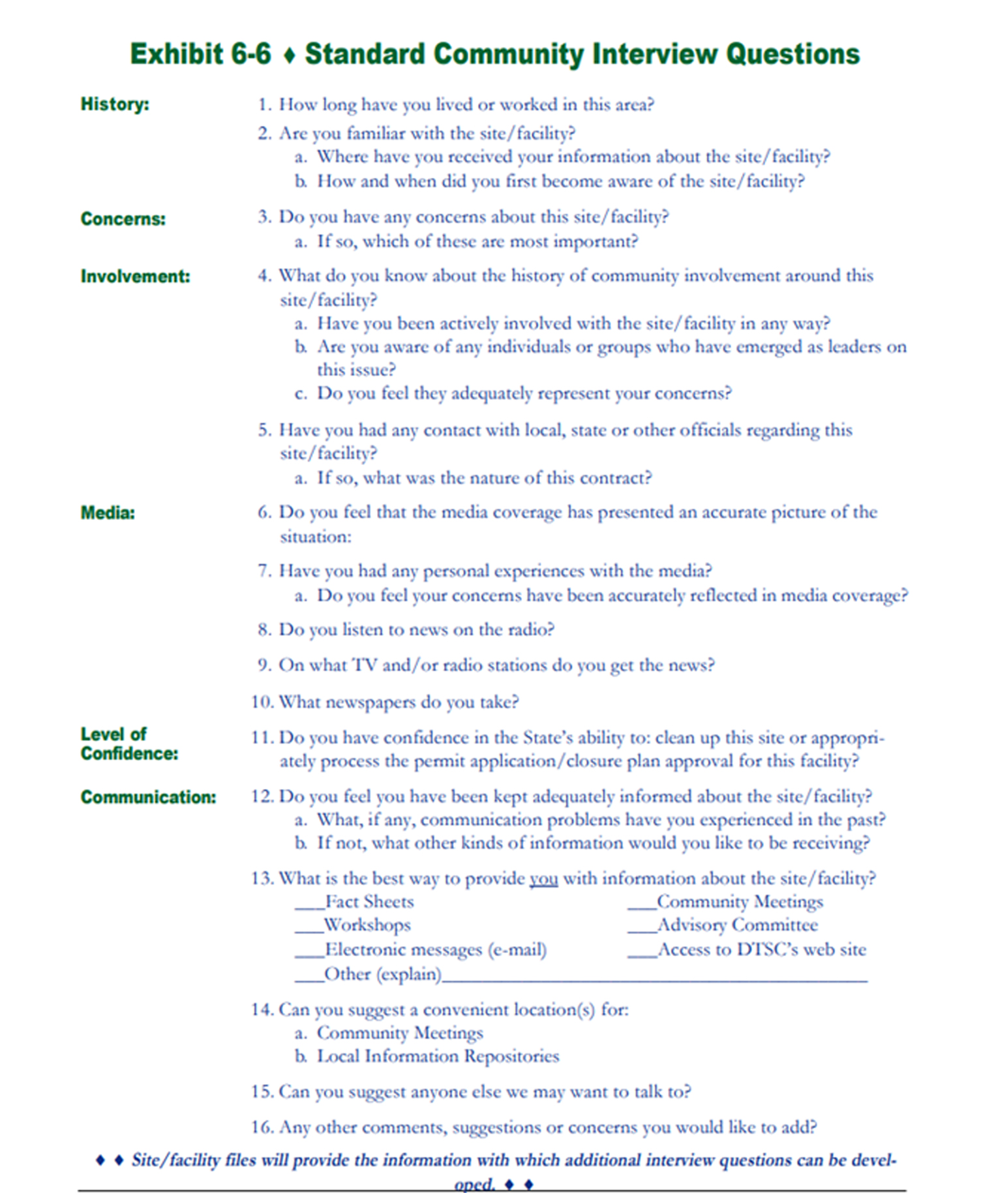Chapter 6: Section A – Community Assessment Process
Overview
The community assessment process allows DTSC to consider potential community interest and informational needs at a hazardous waste facility or a site early in the technical process. Community assessment also helps DTSC to anticipate the nature of possible community concerns and inquiries, and respond appropriately to those inquiries.
There are several types of community assessment, which can be performed, depending upon what is already known about the community’s level of interest, the significance of the site or permit action being proposed, and staff resources available. These include:
- Community Profile – Required during Preliminary Environmental Assessment process, (thumbnail sketch of community, newspaper articles), and provided by the Responsible Party.
- Baseline Community Survey – Required prior to commencement of remedial investigation to corrective action and closure projects. Evaluate potential interest in a project. Also done for facility permits.
- Community Interviews – Required prior to commencement of Remedial Investigation/Feasibility Study field work. Required for “high” community interest removal actions, facility permits, and RCRA Facility Investigation (RFIs).
- RAPID Informal Assessment – Used to informally and quickly determine the impacted community and its concerns during and after an accidental release of hazardous materials or waste.
The decision on what type of assessment is appropriate in a given situation is to be made by the Public Participation Specialist assigned to the project using the following guidelines.
The first step in the community assessment process is to do a rough evaluation of potential community interest at a given site/facility. (See Exhibit 6-1) To judge the level of community interest at a site/facility, project staff should review the following:
- Review DTSC files and records of public inquiries about the site or facility.
- Review DTSC public participation file, if one already exists. If not, this is the time to create a PP file.
A community profile is a report submitted to DTSC by a proponent/applicant under the Fee-For-Service or Voluntary Cleanup programs, or as part of the Preliminary Endangerment Assessment (PEA) process. The profile is used to obtain a “thumbnail sketch” of a community. This is necessary to evaluate whether public involvement activities are warranted at a given time and to identify sites or facilities with “high” community interest or concern early in the process. Refer to Exhibit 6-2, Community Profile Outline.
Responsibilities
Community Profile Task Responsibilities
Timing
The Preliminary Endangerment Guidance Manual (1994), requires that a community profile be prepared for each Preliminary Endangerment Assessment (PEA). However, California Assembly Bill (AB) 2655 (signed into law in September 2000) specifies that only school sites requiring further response actions beyond a PEA are mandated to comply with Superfund public participation requirements set forth in the California Health and Safety Code (HSC). Community Profiles are required by HSC Section 25356.1(h)(1). For all site mitigation sites, except school sites. The community profile should be submitted by the project proponent, along with their Preliminary Endangerment Assessment work plan. This profile must be reviewed by a Public Participation Specialist to determine what activities are warranted. Sites with “high” community interest or concern may require public participation support at this early stage.
In instances when a draft Preliminary Endangerment Assessment report is submitted to DTSC for review without prior review of the work plan, the community profile must be submitted with the draft document. In any case, the community profile must be evaluated by a Public Participation Specialist prior to its approval. A community profile is also submitted to DTSC by a proponent under the Voluntary Cleanup program. This community profile is used by the Public Participation Specialist to help estimate the number of Public Participation Specialist hours that are necessary for the proposed project.
Community profiles for school sites with recommendations for further action should be prepared during the PEA Public Comment Period conducted by the school district. The school district should submit the community profile to DTSC for review and approval upon completion of the public comment period.
Baseline Community Survey
Overview
A baseline community survey (also referred to as a community survey) is a process conducted by a Public Participation Specialist, utilizing questionnaires, display ads and telephone interviews, from Section 25358.7 (b). It is also an opportunity to introduce a project to a community and get some early feedback, including information on sensitive receptors. A baseline community survey cannot take the place of community interviews, which are necessary prior to the development of a Public Participation Plan.
Responsibilities
Baseline Community Survey Task Responsibilities
Timing
A baseline community survey can be performed at the earliest stages of a project. A baseline community survey also can be a useful tool to monitor community interest during the life of a project or evaluate the impact of a change in circumstances.
Community surveys are ideal for evaluating new projects to obtain a general idea of the level of community interest. For known “high” community interest facilities, community interviews should be conducted.
Techniques
- Develop project mailing list (refer to Chapter 6 D for guidance on mailing lists);
- Send out an introductory letter describing the proposed project, DTSC’s role, and public involvement opportunities. Include with the letter, a questionnaire asking about knowledge of, interest in, or concern about project, as well as how to best work with this community. (Refer to the Appendix, for a sample letter.); and,
- Review responses received to obtain feedback on community interest and/or concern. Consider number of responses received (10% is usually a good response to such a mailing), as well as the specific comments provided.
A written survey can be enhanced by the following methods:
Conduct a limited number of telephone interviews with key community leaders (usually 5-7 interviews will suffice) for additional information about community and issues. (Refer to Exhibit 6-6, for examples of telephone interview questions.)
Place a display ad in local newspapers, describing the proposed project, DTSC’s role, and public involvement opportunities. Include a DTSC contact and a tear-out coupon which can be returned for additional information and to be added to the project mailing list.
In addition to these primary techniques, it may be useful to conduct a drive-by site/ facility inspection to gather more information (particularly sensitive receptors) about the community.
Prepare a summary of information received from questionnaires, phone interviews, and/or display ads. From this, develop a public involvement strategy, which is responsive to needs identified by the community. This should include whether additional community assessment efforts are warranted as well as any other public participation activities that are anticipated for the project.
Community Interviews
Overview
Community interviews are individual, in-person interviews, conducted by the Public Participation Specialist and the Project Manager with community members, local officials, and other interested parties to:
- Identify the interested community;
- Obtain historical information about the site/facility;
- Assess community issues and concerns;
- Evaluate level of awareness about a project;
- Obtain an understanding of past community involvement in this or other similar projects;
- Receive input on how to best involve the community in the site mitigation or permit process; and,
- Begin to establish a relationship with local agency and community representatives.
- To meet the requirements of Health and Safety Code Section 25358.7, interviews cannot take the place of a community survey, or vice versa.
- Ability to send/receive electronic correspondence or access to the internet.
Timing
Site Mitigation
Community interviews are the first step in the development of a Public Participation Plan. An approved Public Participation Plan must be in place before Remedial Investigation fieldwork can begin at a site. Interviews can also be done at any time during the site mitigation process, as needed, in order to evaluate changing community make-up, interests, needs or concerns.
HWM
Community interviews should be done for any “high” community interest facilities, when review of the Part B permit application begins or when corrective action is initiated. Refer to Exhibit 6-1, “High Community Interest Criteria”, for guidance on determining whether a facility is considered “high” interest. This determination may change for a facility at any time. The Public Participation Specialist is responsible for determining whether community interviews are necessary for a facility.
Preparing for Interviews
Community interviews are a time-intensive activity because of the large amount of organization required and time needed for interviews. While the level of effort will vary, schedule approximately four hours per interview for research and preparation, the interview itself, and follow-up activities.
Collect background information about the project and community. This information can be collected from other DTSC staff, newspaper reports, DTSC files, a drive-by of the site/facility, other agencies, and the permit application/ closure plan.
Identify contact persons at interested organizations and local agencies. In addition to establishing the community’s level of interest, project staff must identify the organizations, agencies and individuals that have been interested or involved in the site or facility related activities to date. This information can be obtained by reviewing the following materials:
- Newspaper clipping;
- DTSC’s public participation file for the site/facility; and,
- DTSC telephone logs that record site- or facility-related public inquiries.
The Public Participation Specialist conducts the interviews with participation from the Project Manager and responsible party or site mitigation project proponent, if applicable or deemed appropriate by the Public Participation Specialist.
Develop a list of interested parties to interview. The project team must develop a list of community members to be interviewed, including representatives of those persons and organizations identified in the two steps above. Additional efforts should be made to identify those community members who are less vocal or visible, as they will provide additional perspectives and concerns about the site/facility that may not surface during interviews with more actively involved community members. DTSC policy requires the Public Participation Specialist to conduct and/ or participate in the interviews. Project staff should accompany the Public Participation Specialist. Refer to Exhibit 6-5 “List of Individuals and Organizations to Interview”.
Develop a list of interview questions. The interview is an opportunity for community members to express their concerns about the site/facility directly to DTSC, and to have input to the public participation planning process. The questions posed during the interview should, therefore, be open-ended in order to elicit the widest range of community members’ concerns and experiences regarding the site/facility. Questions should be phrased so as not to be leading or biased.
Exhibit 6-6, contains a list of standard interview questions that may be used to guide the interview. This list is not all-inclusive and project staff should develop additional questions that will elicit site/facility-specific or community-specific concerns. For example, if the community has been suspicious or distrustful of local or state government actions or decisions in the past, questions should be asked that will supply DTSC with information on those events and the community’s current attitudes toward local authorities. Site/facility files will provide information with which additional interview questions can be developed.
Arrange the Interviews
Local government and business representatives are likely to prefer meeting in their offices during business hours, local residents and community groups may be available only during non-business hours. Meetings at their homes may be most convenient.
- The interviews may take place within a single community or over a large geographical area. It is important to plan ahead when scheduling the interviews and group them by geographic location to prevent backtracking throughout the day. Depending on the number of interviewees and their geographic locations, one or more days may be required to complete the interviews.
- Staff should allow for up to one hour per interview, plus time to travel to the next appointment. Appointments should be scheduled two to three weeks prior to the interview to allow time to send a letter confirming the date and time, reason for the interview, and topics to be discussed.
- Interpreter should be used when interviewing community members who speak a language other than English.
Conducting the Interviews
Explain Purpose
The Public Participation Specialist will begin the interview with a brief overview of the project, and explain that the primary goal of the interview is to obtain rather than disseminate information. The information gathered during the interview is used to assess community concerns, and to develop an appropriate public participation strategy. While DTSC staff may answer questions or provide a brief summary about DTSC activities and findings, the interview is not intended to serve as a formal briefing.
Assure Confidentiality
Explain that while the public involvement plan will be part of the project file, the plan will not attribute specific statements or information to any individual. Ask interviewees if they would like their names, addresses, and telephone numbers on the mailing list.
Identify Other Interested Parties
Determine the interviewee’s perception of past DTSC or site or facility public participation activities.
Identify Concerns About Site/Facility
When identifying citizens’ concerns about the site or facility concerns, consider the following factors:
- Threat to health or the environment
- Economic concerns
- Sensitive Receptors
- Agency credibility
- Community involvement
- Media Coverage (local, state, national)
Number of households/business affected
Future Public Involvement in Project
Explain the public involvement process, and ask the interviewees:
- How they would like to be involved and informed of the project progress (keep a list of individuals who wish to be kept informed);
- What is the best way to stay in contact;
- To recommend convenient locations for holding public meetings and setting up information repositories.
- Do they have the ability to send/receive electronic comments or access the internet?
Community Interviews Summary
Summary of community concerns should be written up at the completion of community interviews. This can be incorporated into the Public Participation Plan or, when no Public Participation Plan is required, can become the basis for a memo to file, outlining a public participation strategy for the project.
Exhibit 6-5
List of Individuals & Organizations to Interview
(**denotes must contact for interview)
**Residents located close to the site/facility
**Businesses located close to the site/facility
Local chapter of the League of Women Voters
Parent-Teachers Associations and school principals
Chamber of Commerce
Civic groups
** Appropriate City Council Member(s)
** City Planning Department
** County Supervisor(s)
Statewide environmental groups
University or community college leaders
** Representatives of State and local agencies such as the Regional Water Quality
Control Board (RWQCB) and the Air District
** Representatives of the local Public or Environmental Health Department
** State legislators
** Federal legislators (federal legislators are only required at federal sites or RCRA facilities or NPL sites and should be considered at “high “ profile state sites/ facilities).
Local/Regional community or environmental groups
** Sensitive receptors (e.g., Hospitals, Schools, Parks, Day Care Centers)




